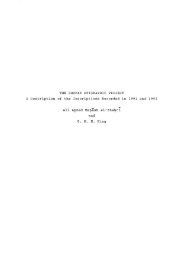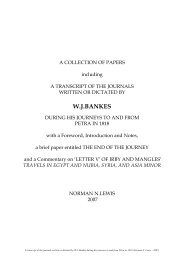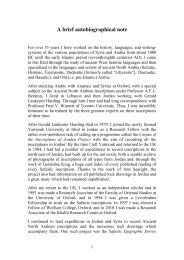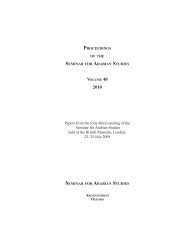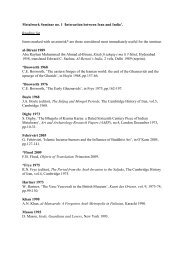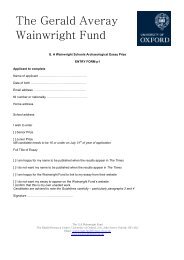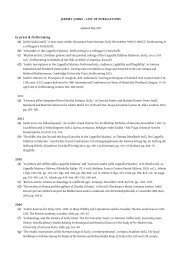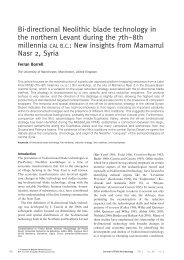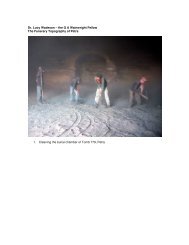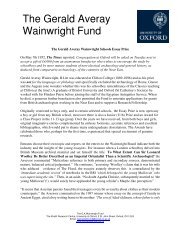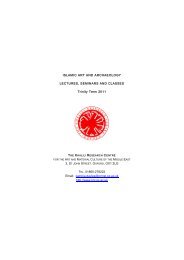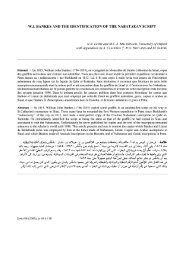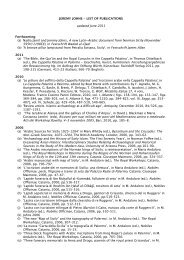Reflections on the linguistic map of pre-Islamic Arabia - Khalili ...
Reflections on the linguistic map of pre-Islamic Arabia - Khalili ...
Reflections on the linguistic map of pre-Islamic Arabia - Khalili ...
Create successful ePaper yourself
Turn your PDF publications into a flip-book with our unique Google optimized e-Paper software.
93 See, for instance, Müller, Das Altarabische und<br />
das klassische Arabisch: 18, 22, 24; and Müller<br />
WW. Some Remarks <strong>on</strong> <strong>the</strong> Safaitic Inscripti<strong>on</strong>s.<br />
PSAS 10: 1980: 69.<br />
94. JSLih 81/2–3 hn-// qbr. It should be noted that<br />
it is not clear from <strong>the</strong> published photograph<br />
whe<strong>the</strong>r <strong>the</strong> first three lines <strong>of</strong> JSLih 81 are<br />
really complete (see Jaussen A & Savignac M-R.<br />
Missi<strong>on</strong> archéologique en Arabie, 2. Paris: Geuthner,<br />
1914: pl. LXXXV). The article hn- appears<br />
to be at <strong>the</strong> end <strong>of</strong> line 2 and qbr at <strong>the</strong> beginning<br />
<strong>of</strong> line 3. But <strong>the</strong> syntax <strong>of</strong> <strong>the</strong> text as recorded<br />
by Jaussen and Savignac is awkward<br />
and has not yet received a c<strong>on</strong>vincing inter<strong>pre</strong>tati<strong>on</strong>.<br />
The ends <strong>of</strong> lines 4–6 appear to be missing<br />
(<strong>the</strong>y are ap<strong>pre</strong>ciably shorter than lines 1–<br />
3) and it is possible that lines 1–3 are also incomplete.<br />
If this is so, <strong>the</strong> definite article hn- in<br />
line 2 would have referred to a noun no l<strong>on</strong>ger<br />
visible at <strong>the</strong> ‘end’ <strong>of</strong> that line, ra<strong>the</strong>r than to<br />
qbr. Only a re-investigati<strong>on</strong> <strong>of</strong> <strong>the</strong> original will<br />
solve this problem. In all o<strong>the</strong>r cases <strong>the</strong> article<br />
is h- before words beginning with q (h- qbr in<br />
JSLih 79/2–3, h- qrt in JSLih 64/1, 366/2, JaL<br />
85d/1ΩJamme, Miscellanées 7: 73–74, pl. 19).<br />
95. LP 87. See Macd<strong>on</strong>ald, Nomads and <strong>the</strong> Hw awrān:<br />
308 for this reading.<br />
96. NH 6.32.157 Avalitae (oppida Domata, Haegra).<br />
97. Thus <strong>the</strong> epi<strong>the</strong>t <strong>of</strong> <strong>the</strong> goddess hn- $ lt at Tell el-<br />
Mashūtw a and, in Hasaitic, <strong>the</strong> names $ mt-hn- $ lt<br />
(LivH A.13/2 Pl.87A), c wd-hn- $ lt (LivH O.15/2–3<br />
Pl.85D), $ ws 1 -hn- $ lt (Ry 155/2–3, see Ryckmans<br />
G. Inscripti<strong>on</strong>s sud-arabes. Quatrième série [Ry<br />
155–202]. Le Musé<strong>on</strong> 50: 1937: 239–240) and {.}rmhn-<br />
$ lt (Ja 1043, see Jamme, Sabaean and Hw asaean<br />
Inscripti<strong>on</strong>s: pl. XV). One <strong>of</strong> <strong>the</strong> excepti<strong>on</strong>s is <strong>the</strong><br />
name hn- c bd in Ja 1044/2 (ATLAL 8: 1984: pl.<br />
89A). The o<strong>the</strong>r is hn- $ mlt, <strong>on</strong> which see below.<br />
98. JaS 162a (Jamme A. Safaitic Inscripti<strong>on</strong>s from<br />
<strong>the</strong> Country <strong>of</strong> c Ar c ar and Ra $ s al- c Anānīyah. In:<br />
Al<strong>the</strong>im F & Stiehl R, eds. Christentum am Roten<br />
Meer, 1. Berlin: De Gruyter, 1971: 93, 634), cf.<br />
Ar. $ imla ‘hope’. The letters l and n are clearly<br />
differentiated in this text.<br />
99. Wilkins<strong>on</strong>-Mulayhw a 1 (Robin, Documents de<br />
l’Arabie antique 3: 80) which A.F.L. Beest<strong>on</strong> read<br />
nfs 1 w-qbr Dryt fty $ mlk n ‘gravest<strong>on</strong>e and grave <strong>of</strong><br />
Dhariyyat servant <strong>of</strong> <strong>the</strong> kings’. However, as<br />
Robin rightly points out, $ mlk n may be a pers<strong>on</strong>al<br />
name equivalent to <strong>the</strong> Arabic clan name al-<br />
Amlūk.<br />
100. As in Hismaic (see below), affiliati<strong>on</strong> to a social<br />
group is always marked by <strong>the</strong> phrase d $ l ‘who<br />
is <strong>of</strong> <strong>the</strong> lineage <strong>of</strong>’ and, so far at least, never by<br />
<strong>the</strong> nisba.<br />
THE LINGUISTIC MAP OF PRE-ISLAMIC ARABIA<br />
101. For <strong>the</strong> most recent treatment <strong>of</strong> this text and its<br />
significance see Macd<strong>on</strong>ald MCA. Trade Routes<br />
and Trade Goods at <strong>the</strong> Nor<strong>the</strong>rn End <strong>of</strong> <strong>the</strong><br />
‘‘Incense Road’’ in <strong>the</strong> First Millennium B.C. In:<br />
Avanzini A, ed. Pr<strong>of</strong>umi d’<strong>Arabia</strong>. Atti del<br />
c<strong>on</strong>vegno. Roma: Saggi di Storia Antica, 11:<br />
1997: 338–340, and references <strong>the</strong>re.<br />
102. The text is damaged at <strong>the</strong> beginning <strong>of</strong> <strong>the</strong> list<br />
<strong>of</strong> scripts.<br />
103. Lipinski E. De fenicische inscripties uit Karatepe.<br />
In: Veenh<strong>of</strong> KR, ed. Schrijvend Verleden. Documenten<br />
uit het oude Nabije Oosten vertaald en toegelicht.<br />
Leiden: Ex Oriente Lux, 1983: 54; and Lipinski<br />
E. Phoenicians in Anatolia and Assyria.<br />
OLP 16: 1985: 82. Luwian having no exact equivalent<br />
to /sw /, s was used as <strong>the</strong> nearest approximati<strong>on</strong>.<br />
The late J<strong>on</strong>as Greenfield suggested that<br />
<strong>the</strong> term ‘script <strong>of</strong> Tyre’ could have been used to<br />
cover Aramaic as well as Phoenician since <strong>the</strong><br />
distincti<strong>on</strong> between <strong>the</strong> two alphabets would not<br />
have been obvious at this period (Greenfield J. Of<br />
Scribes, Scripts and Languages. In: Baurain C,<br />
B<strong>on</strong>net C & Krings V, eds. Phoinikeia Grammata.<br />
Lire et écrire en Méditerranée. Actes du Colloque de<br />
Liège, 15–18 novembre 1989. Namur: Collecti<strong>on</strong><br />
d’Études Classiques, 6: 1991: 179–180).<br />
104. Greenfield, Of Scribes: 180–181 and, independently,<br />
Livingst<strong>on</strong>e A. New light <strong>on</strong> <strong>the</strong> ancient<br />
town <strong>of</strong> Taimā. In: Geller MJ, Greenfield JC &<br />
Weitzman MP, eds. Studia Aramaica. New Sources<br />
and New Approaches. Papers Delivered at <strong>the</strong><br />
L<strong>on</strong>d<strong>on</strong> C<strong>on</strong>ference <strong>of</strong> <strong>the</strong> Institute <strong>of</strong> Jewish<br />
Studies University College L<strong>on</strong>d<strong>on</strong> 26th-28th<br />
June 1991. Oxford: Journal <strong>of</strong> Semitic Studies<br />
Supplement, 4: 1995: 133–137.<br />
105. I am most grateful to Pr<strong>of</strong>essor David Hawkins,<br />
who is publishing an editi<strong>on</strong> <strong>of</strong> this text, for this<br />
informati<strong>on</strong>. He himself suggested that ta-i-mani-ti<br />
referred to <strong>the</strong> Aramaean tribe <strong>of</strong> Tēmān<br />
in nor<strong>the</strong>rn Mesopotamia, but this was mainly<br />
because he felt that it would be inc<strong>on</strong>ceivable<br />
that Aramaic would not be am<strong>on</strong>g <strong>the</strong> scripts<br />
menti<strong>on</strong>ed. However, as he points out, <strong>the</strong> beginning<br />
<strong>of</strong> <strong>the</strong> list is broken and we do not<br />
know what has been lost. Moreover, he agrees<br />
with Greenfield that Yariris is unlikely to have<br />
distinguished between <strong>the</strong> Phoenician and Aramaic<br />
scripts (pers. comm.). The gentilic form<br />
Taymā $ is attested as tymny $ in Nabataean texts<br />
from Hw egrā (H 1/2, 12/2) although this, <strong>of</strong><br />
course, is from a very much later period (first<br />
century AD), see Healey JF. The Nabataean Tomb<br />
Inscripti<strong>on</strong>s <strong>of</strong> Mada $ in Salih. Oxford: Journal <strong>of</strong><br />
Semitic Studies Supplement, 1: 1993: 71.<br />
106. I have explored <strong>the</strong>se relati<strong>on</strong>ships in Macdo-<br />
71



